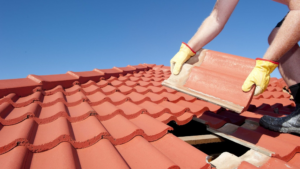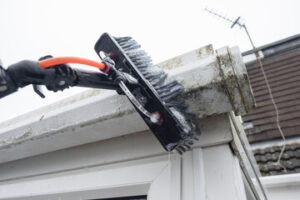A building’s roof protects it from rain and other weather elements. Without roofers, structures would be vulnerable to leaks and other damage.
Roofing involves working on residential and commercial buildings, often using ladders or scaffolding to access the roof. Resources on safety include ladder safety mobile apps, infographics and tipsheets, and training in safe work at heights. Contact Burlington Roofing now!

Choosing the right roofing materials is an important part of any home improvement project. Whether you’re repairing a leaky roof or installing a new one, there are many different options for materials and designs. Each type of roofing material has its own advantages and disadvantages, so it’s important to find the right fit for your needs and climate.
Shingles and shakes are popular roofing materials because they offer a natural look. They also provide natural insulation and are eco-friendly, but they require routine maintenance to avoid damage from rot or insects. Wood shingles and shakes typically last 30 to 50 years and are available in a variety of species, including redwood and cedar.
The underlayment is the layer of wood used to secure shingles and other roofing materials to the roof deck. It protects the roof from moisture and helps prevent leaking. There are two types of underlayment: felt and self-adhered. Felt underlayment is usually made from wood cellulose or fiberglass, and it’s available in several weights. The thicker 30-lb. underlayment is recommended for areas at risk of leaking, such as the eaves and valleys.
Rubber membranes are a great choice for flat or low-sloped roofs because they’re durable, waterproof and fire-resistant. They’re also inexpensive and easy to install. Some of the most common rubber membranes include EPDM, TPO and PVC.
BUR (built-up roofing) is another common option for flat or low-sloped roofs. It’s composed of layers of organic or glass-fiber mats that are saturated with bitumen. The top layer is coated with asphalt, coal tar or cold-applied adhesive. It’s usually installed over a concrete or wood deck and is resistant to chemicals, punctures and UV radiation.
Tile roofing is an expensive option that can add a unique aesthetic to your home. It’s available in a variety of colors and styles, and it can resist extreme heat and rain. However, it can become fragile in extremely cold temperatures and requires regular maintenance to keep water from seeping into the home. Other options for tile roofs include concrete, terracotta and slate.
Installation
Before starting any roofing work, it is important to protect surrounding objects and landscaping using tarps and to cover them with a layer of protective material. Ensure that any vehicles or lawn furniture are moved away from the area and that the work space is large enough to accommodate a worker moving about on the roof. The contractor should also protect the eaves with drip edge flashing and install valley flashing along the roof valleys, as well as ice and water sheathing. They should also use flashing around chimneys, wood stove pipes, and certain vents.
The roofer will then begin installing shingles. They will overlap each row by at least six inches and nail them in a pattern that combines close nails near the edge and more spread out nails towards the center.
Maintenance
A roofing system is an integral part of any building and needs to be kept in good repair to ensure it remains in service. This is particularly important in geographic areas that experience a wide range of weather types and temperatures.
Ideally, roofs should be inspected regularly (on a biannual basis, once in the Spring and once in the Fall) by trained personnel to enable early detection of problems that can otherwise remain hidden until they become major and expensive. Regular inspections should also be made after extreme weather events and after construction activities that could affect the condition of the roofing system.
During these inspections, the entire surface of the roof should be surveyed for visible damage, including missing shingles, damaged flashing around chimneys and vents, and any wear around the edges of the roofing system. A maintenance checklist can be useful for documenting these findings, and a procedure should be established to follow it regularly, possibly tailored to each roof type. Safety equipment should be on hand for workers, especially when working at heights.
Repairs
If your roof has suffered damage or is showing signs of aging, a repair may be necessary. Unlike a replacement, repairs are targeted solutions meant to address issues in specific areas of your roof. They can be more affordable and are ideal for roofs in otherwise good condition with isolated problems.
Leaks are a common concern for homeowners, especially with built-up roofing (BUR). To fix leaks in a BUR roof, carefully inspect the area to identify and correct the source of the problem. Remove the damaged layer of the roof to reveal the underlying felt, clean and dry the area, and apply roofing cement to repair the leak.
Structural changes, full tear-offs, and changing the shape or weight of a roof often require a permit from the DOB. Be sure to work with a licensed contractor who can create official plans and submit them for approval.
Weather Protection
Roofing is designed to protect the interior of homes and businesses from extreme weather conditions like rain, heat and cold. In addition, roofing helps to protect from wind, heavy snow and hail. However, some roofing materials are better suited to certain types of weather conditions than others.
During a storm, debris such as broken tree branches, dirt and mud, and acorns can become lodged against the roof and cause damage. A roof should be regularly inspected to make sure that there are no weak spots or holes that could allow rain to leak into the house.
To help prevent further damage, a temporary roofing solution like Stormseal can be used to shield the building until permanent repairs can be made. This polyethylene film is heat-shrinkable and securely wraps the entire damaged area, protecting it from further wind, rain and hail until the repair work is complete. Unlike tarps, this innovative product is installed once and stays on for as long as it takes to get the building back in service.
Another form of weather protection is to fit an extra layer of water-resistant material under the shingles on the top part of the roof. This is known as weather guard or ice shielding and is an essential part of any Inclement Weather Plan. This will safeguard against water infiltration into the home’s plywood, insulation and drywall when ice dams or gutters become blocked. Also, it prolongs the lifespan of the shingles on the roof by keeping them dry. This can be done easily with a little forethought and planning.
Curb Appeal
Few elements of a home or building have as much impact on the overall aesthetics and curb appeal as the roof. A well-chosen and beautifully maintained roof can elevate a property’s look, and it can even enhance its value.
The term “curb appeal” is often used to describe the attractiveness of a property from the street or sidewalk, and it encompasses everything from landscaping and exterior paint to windows, doors, and even a house’s number plate or mailbox. Curb appeal can make or break a first impression on visitors, and it is an important element to consider when designing a new home or renovating an existing one.
Many homeowners focus on enhancing their property’s curb appeal, and many of these tasks are relatively inexpensive. The most common ways to improve a home’s curb appeal include a fresh coat of paint, cleaning up the landscape outside, or replacing items like an outdated light fixture or mailbox. While it may seem obvious that a well-maintained lawn, fresh paint, and attractive landscaping are critical to curb appeal, it is also important to remember that the roof plays a major role in protecting a property and defining its visual appeal.
